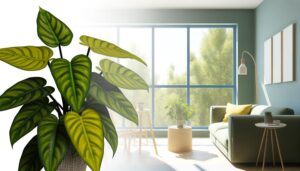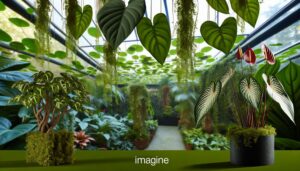Why Are the Leaves of My Philodendron Selloum Turning Brown?
Brown leaves on a Philodendron Selloum often signify issues with water, light, nutrients, pests, or environmental stress. Overwatering leads to root hypoxia, while underwatering causes desiccation, both resulting in browning.
Direct sunlight can induce photoinhibition, whereas low light hampers photosynthesis. Nutrient deficiencies, particularly nitrogen, phosphorus, and potassium, disrupt physiological processes, causing chlorosis and necrosis.
Infestation by pests like spider mites or diseases such as Xanthomonas can also lead to brown lesions. These factors affect the plant's physiology and overall health.
Understanding these elements can help you take corrective measures.
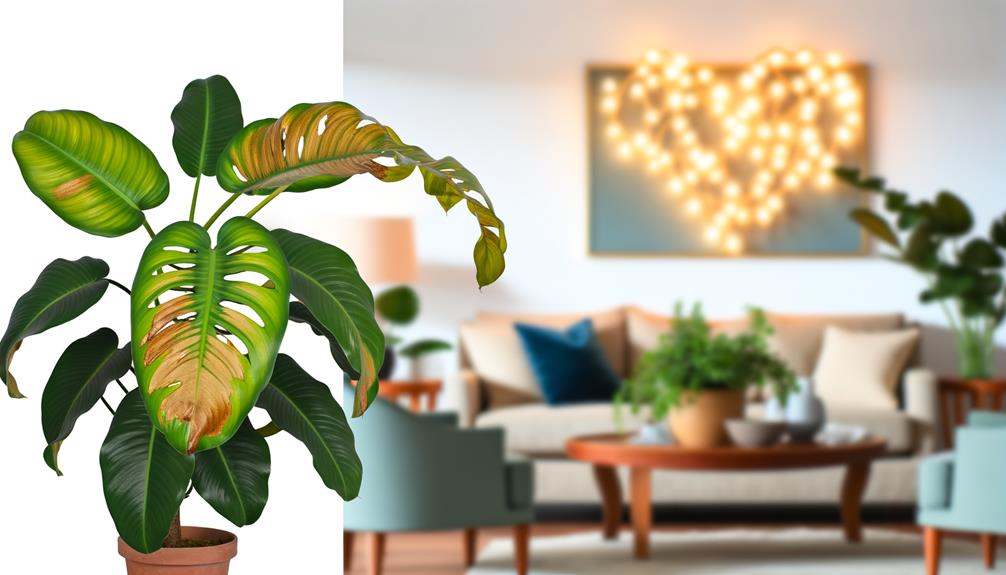
Key Takeaways
- Overwatering causes root hypoxia, leading to leaf necrosis and browning.
- Direct sunlight results in photoinhibition, causing brown leaf margins.
- Nutrient deficiencies, especially potassium, impair stomatal function, causing browning.
- Pests like spider mites and aphids siphon sap, leading to leaf browning.
- Low humidity increases transpiration rates, resulting in leaf desiccation and browning.
Watering Issues
Improper watering practices, including both overwatering and underwatering, can significantly contribute to the browning of Philodendron Selloum leaves due to the disruption of water and nutrient uptake mechanisms in the plant.
Overwatering leads to waterlogged soil, causing root hypoxia, which impairs root function and nutrient absorption, subsequently resulting in leaf chlorosis and necrosis.
Conversely, underwatering induces water stress, limiting the plant's ability to transport essential nutrients and maintain turgor pressure, thereby causing leaf desiccation and browning.
Both conditions can adversely affect the root's symbiotic relationships with mycorrhizal fungi, further exacerbating nutrient deficiencies.
Maintaining ideal soil moisture levels is crucial for ensuring the physiological processes essential for healthy foliage in Philodendron Selloum. Regular monitoring and appropriate soil drainage are essential for mitigating these issues.
Lighting Conditions
Adequate lighting conditions are essential for the best photosynthetic performance and overall health of Philodendron Selloum, as insufficient or excessive light exposure can disrupt chlorophyll production and lead to the browning of leaves.
This species thrives in bright, indirect light. Direct sunlight can cause photoinhibition, leading to cellular damage and necrosis, manifesting as brown leaf margins. Conversely, inadequate light reduces photosynthetic efficiency, limiting carbohydrate production and causing leaf chlorosis and eventual browning.
To optimize light conditions, place the plant near a north or east-facing window, ensuring it receives diffused light. Artificial grow lights can supplement natural light, maintaining chlorophyll synthesis without the risk of photodamage, thereby promoting a robust and verdant foliage.
Pests and Diseases
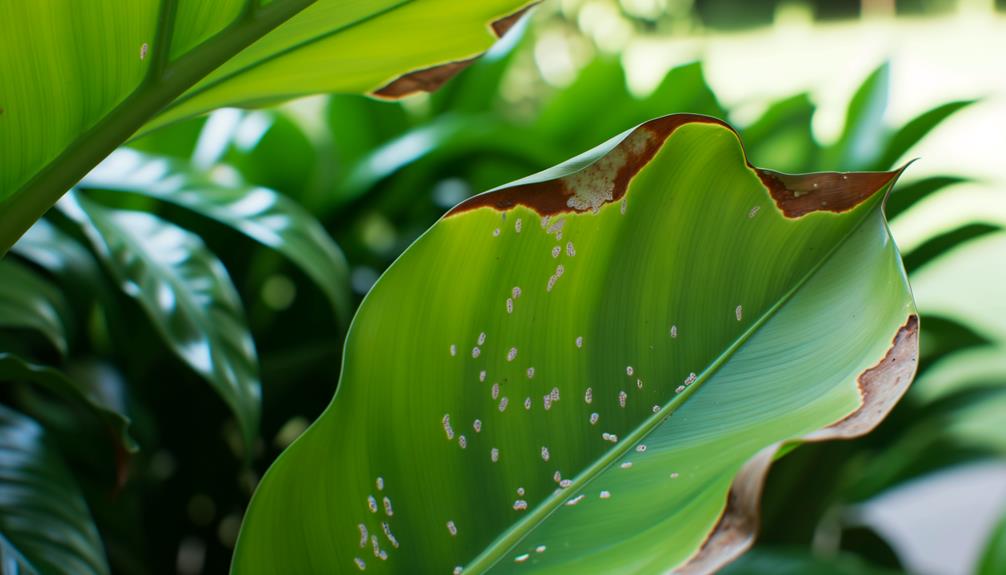
In addition to ideal lighting conditions, the health of Philodendron Selloum can be compromised by various pests and diseases, which often manifest as brown discoloration on the leaves. Common pests include spider mites, aphids, and mealybugs, which siphon sap from the plant, leading to chlorosis and necrosis.
Fungal infections such as leaf spot caused by Xanthomonas campestris also result in brown lesions. Bacterial pathogens, particularly Erwinia, may induce wet, slimy spots that progress to extensive browning.
Early detection through regular examination of leaf undersides and stems is essential. Implementing integrated pest management (IPM) strategies, such as biological control agents and fungicidal treatments, can mitigate these issues, preserving the physiological health of the plant.
Nutrient Deficiency
A deficiency in crucial nutrients can manifest as brown discoloration on the leaves of Philodendron Selloum, disrupting chlorophyll production and overall plant vigor. Key nutrients such as nitrogen, phosphorus, and potassium are essential for maintaining the plant's metabolic functions.
Nitrogen deficiency impedes chlorophyll synthesis, leading to chlorosis and subsequent browning. Inadequate phosphorus results in poor energy transfer, affecting cellular functions and promoting necrotic patches. Potassium is crucial for water regulation and enzyme activation; its scarcity hinders stomatal function, causing marginal leaf browning.
Micronutrients like magnesium and iron also play significant roles in photosynthesis and enzyme activity. A balanced fertilization regime tailored to the specific needs of Philodendron Selloum is necessary to prevent these nutrient-related discolorations.
Environmental Stress
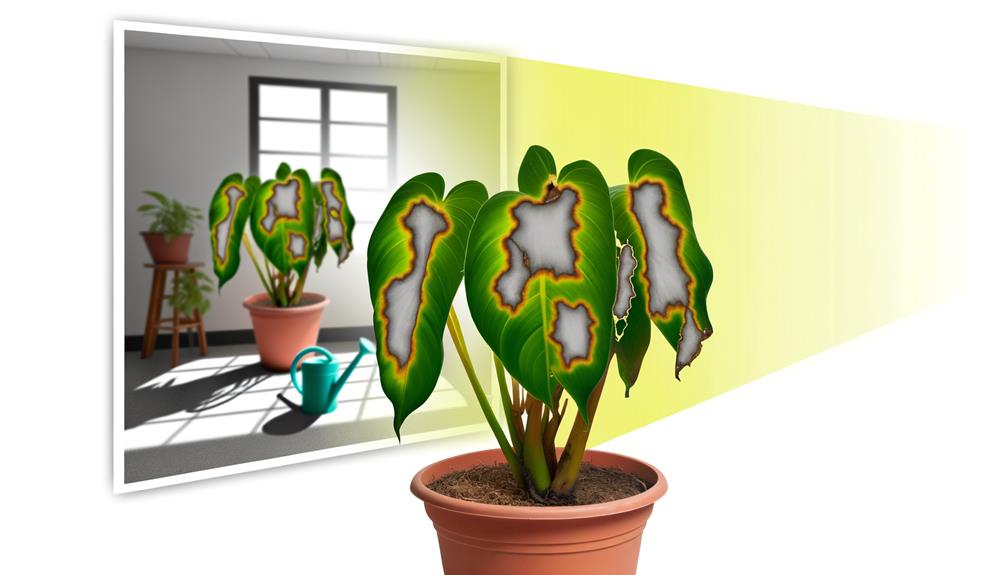
Beyond nutrient deficiencies, environmental stressors such as insufficient light, improper watering, and extreme temperatures can further worsen browning in Philodendron Selloum leaves. Inadequate light hinders photosynthesis, leading to chlorosis and eventual browning.
Overwatering or poor drainage results in root hypoxia, disrupting water and nutrient uptake, showing as leaf necrosis. Conversely, underwatering causes cellular dehydration, resulting in leaf desiccation.
Temperature extremes, particularly below 55°F or above 85°F, can impair enzymatic functions and disrupt cellular balance, leading to tissue damage. Additionally, low humidity can worsen transpiration rates, increasing water loss and leaf browning.
Understanding and mitigating these environmental stressors are essential for maintaining ideal physiological conditions and preventing the harmful effects on Philodendron Selloum foliage.
Conclusion
To sum up, the browning of Philodendron selloum leaves can be attributed to various factors including improper watering, inadequate lighting, pest infestations, nutrient deficiencies, and environmental stress.
Remarkably, over 70% of houseplant ailments are linked to incorrect watering practices. Understanding the plant's specific needs and environmental conditions is essential for its best health.
By addressing these factors, the vibrancy and longevity of Philodendron selloum can be greatly improved, ensuring its continued aesthetic and physiological vitality.



